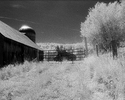laroygreen
Member
Hey guys,
So after mulling over the idea of setting up a darkroom for colour printing - I came across some material on doing Carbon Color Printing and I have been completely smitten! From what I understand so far, while carbon printing is much more time consuming, it actually seems a lot more practical for where I live as I wouldn't need a license to import chemistry (RA-4 is considered hazardous, but potassium dichromate is readily available locally from specialized sellers) and I wouldn't need to completely light proof (and also keep safe, well ventilated and cool) a room (currently a major challenge because I rent).
From the opinions floating around, it seems that carbon color printing is a fools errand (I bought the Luminous Landscape journal episode 20 - and in the traditional way it would be, but I would do inkjet separation negatives which would remove a lot of the frustration they were talking about); but other than the time commitment, patience and fastidiousness required, I really don't see any other barriers to entry (but I could be wrong).
(I bought the Luminous Landscape journal episode 20 - and in the traditional way it would be, but I would do inkjet separation negatives which would remove a lot of the frustration they were talking about); but other than the time commitment, patience and fastidiousness required, I really don't see any other barriers to entry (but I could be wrong).
I know there is still a lot to learn about the process before committing to do it, so can anyone recommend a book or other resource that could give more details? Most of what I found are videos on Youtube that are really good, but lack certain details (e.g. mixing colour pigment ratios, temperatures, sizing, gelatin coating, soak time, dry time, determining exposures, etc.) or webpages that are dedicated to only black and white printing with carbon (seems similar to colour pigment, just 4 times as long).
Also, if there are any reasons (other than what I listed above) to not do this process, please share! I understand that this would be a very long road, and I would need to start doing black and white printing before I can move up to colour; but it makes sense to map the whole journey before investing in the process (I have nothing against BW, but 90% of what I shoot and print is in colour; I wouldn't attempt a process that would not get me to colour eventually).
Thanks!
So after mulling over the idea of setting up a darkroom for colour printing - I came across some material on doing Carbon Color Printing and I have been completely smitten! From what I understand so far, while carbon printing is much more time consuming, it actually seems a lot more practical for where I live as I wouldn't need a license to import chemistry (RA-4 is considered hazardous, but potassium dichromate is readily available locally from specialized sellers) and I wouldn't need to completely light proof (and also keep safe, well ventilated and cool) a room (currently a major challenge because I rent).
From the opinions floating around, it seems that carbon color printing is a fools errand
 (I bought the Luminous Landscape journal episode 20 - and in the traditional way it would be, but I would do inkjet separation negatives which would remove a lot of the frustration they were talking about); but other than the time commitment, patience and fastidiousness required, I really don't see any other barriers to entry (but I could be wrong).
(I bought the Luminous Landscape journal episode 20 - and in the traditional way it would be, but I would do inkjet separation negatives which would remove a lot of the frustration they were talking about); but other than the time commitment, patience and fastidiousness required, I really don't see any other barriers to entry (but I could be wrong). I know there is still a lot to learn about the process before committing to do it, so can anyone recommend a book or other resource that could give more details? Most of what I found are videos on Youtube that are really good, but lack certain details (e.g. mixing colour pigment ratios, temperatures, sizing, gelatin coating, soak time, dry time, determining exposures, etc.) or webpages that are dedicated to only black and white printing with carbon (seems similar to colour pigment, just 4 times as long).
Also, if there are any reasons (other than what I listed above) to not do this process, please share! I understand that this would be a very long road, and I would need to start doing black and white printing before I can move up to colour; but it makes sense to map the whole journey before investing in the process (I have nothing against BW, but 90% of what I shoot and print is in colour; I wouldn't attempt a process that would not get me to colour eventually).
Thanks!





 ... this video (and the one entitled "ultrastable" on youtube) may be all the information I need, but I really can't say if the parts left out are the really hard parts - seems all a bit too easy
... this video (and the one entitled "ultrastable" on youtube) may be all the information I need, but I really can't say if the parts left out are the really hard parts - seems all a bit too easy 